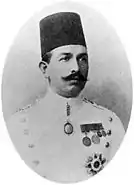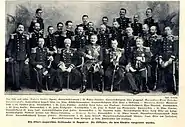
Paul Dittrich (11 November 1868, Vienna, Austro-Hungarian Empire – 30 December 1939, Salzburg, Nazi Germany) was an Austrian photographer who established himself in Ottoman Egypt in 1894. He succeeded Ignaz Heyman at Heyman's studio in Cairo. Dittrich was one of the photographers to the Court of Egypt.
American journalist Amédée Baillot de Guerville refers to him in his book New Egypt (1905) by stating:
"To those in Cairo I can thoroughly recommend either M. Lekégian or M. Dittrich, photographer to the Court. The latter has a wonderful collection of portraits, admirably done, of all the more important persons. His rooms are a real museum of all the celebrities, masculine and feminine, whom Cairo has known in the last five-and-twenty years."[1]
Gallery
 Khedive Abbas II of Egypt, c. 1900
Khedive Abbas II of Egypt, c. 1900_-_TIMEA.jpg.webp) A Man in traditional dress, 1918
A Man in traditional dress, 1918_-_TIMEA.jpg.webp) A veiled woman in traditional dress, 1918
A veiled woman in traditional dress, 1918_-_TIMEA.jpg.webp) The Mosque of Mohamed Ali, 1906
The Mosque of Mohamed Ali, 1906_-_TIMEA.jpg.webp) Ghezireh Bridge (1906)
Ghezireh Bridge (1906)_-_TIMEA.jpg.webp) The Pulpit and Middle-Screen of the Church of Abu Sergeh. (1918)
The Pulpit and Middle-Screen of the Church of Abu Sergeh. (1918)_-_TIMEA.jpg.webp) French Diplomatic Agency (1906)
French Diplomatic Agency (1906) Officers of the Austro-Hungarian Navy on a visit to Egypt, 1906
Officers of the Austro-Hungarian Navy on a visit to Egypt, 1906
References
- ↑ Guerville, Amédée Baillot de (1905). "Introduction". New Egypt. London: W. Heinemann. p. xiii. ISBN 9781931956659. OCLC 5663657. Retrieved 23 July 2009.
Further reading
- Hannavy, John (2008). Encyclopedia of nineteenth-century photography. New York, NY: Routledge. ISBN 978-0-415-97235-2. OCLC 123968757.
- Jacobson, Ken (2007). Odalisques & Arabesques: Orientalist Photography 1839-1925. London: Quaritch. ISBN 9780955085253, OCLC 883254420.
- Perez, Nissan N. (1988) Focus East: Early Photography in the Near East 1839-1885. New York: Harry N. Abrams, Inc.